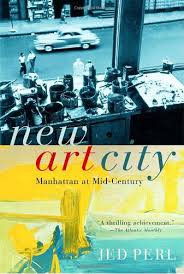Gotham Art
Ever read a well-reviewed book and simply have it not click? You may like the topic and think highly of the author – but still, the book just refused to engage with you. Reading it becomes a chore and a source of frustration. It isn’t just that the book isn’t working. More troublesome is a worrisome sense of personal shortcoming – or at least that is what I feel. It has to be me, the reader, and not the book. Or maybe I just read too much into reading.
That, in a nutshell, is what happened to me with Jed Perl’s New Art City: Manhattan at Mid-Century. Perl is a well-known art critic. I do not always agree with him, but I’ve read his pieces in the popular press and have been impressed. He produces a new book every few years, too, and they are usually well-received.
As for the New York City art scene, I am an engaged fan – historically and in terms of contemporary art. From the work of Samuel Morse in the early 1800s through PS1 in recent years, New York City has been a hive of artistic creativity. It has been a particularly important site for collaboration and competition for certain groups of artists at set times. The Ashcan School in the early years of the 1900s, Harlem in the 1920s, and the modernists after World War II stand out as exemplary case studies of the power of Gotham to shape artists and the art world. I’ve read, visited, viewed, talked and learned about art in NYC for many years. I picked up New Art City with high hopes.
Unfortunately, I could not make the book work for me. Perhaps it was the black and white illustrations of colorful and vibrant art. It might have been the encyclopedic nature of the tome: everyone who painted in NYC from WWII until the mid-1960s gets a mention, a paragraph or a chapter. Maybe it was an absence of any real discussion of what was going on in the city at the time: the changing physical landscape, the vitality of so many other forms of creative expression: music, dance, theater, and popular culture. It could stem from Perl’s linkage and comparisons of artist to artist from a critic’s perspective. I, however, wonder if the call and response was real (my instinct is that it is often the creation of critics). If Hans Hoffman truly was the gatekeeper to mid-century art, was it due to his teaching, his talking, or his work? Or it might be the lack of a clear reason to bounce from artist to artist to artist.
In the end, I stopped caring as artist after artist and painting after painting found its way into the narrative. Was everyone really rebelling against the abstract expressionists? Was de Kooning that charismatic? The island might serve as a good organizing principle for a book or exhibit, but that does not make it compelling. Even as I like Hoffman, de Kooning, Pollack, and so many others discussed here, New Art City just is not my cup of tea. And having giving the book time and consideration, I am also sure it’s not just me.
David Potash